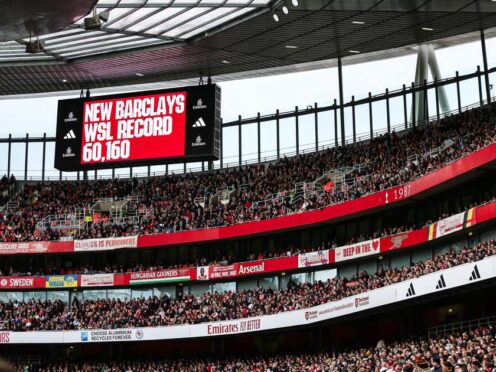
Women’s Super League attendances are up 43 per cent on last season as Arsenal lead the charge to show the league “belongs” in larger venues.
From an average crowd of 5,222 last term, a move to play more games at Premier League stadia coupled with an overall upturn in interest has seen this season’s figure jump to 7,478.
Arsenal have played five games at the Emirates Stadium this season and only three at their “regular” venue Meadow Park – home of men’s National League side Boreham Wood – and have sold out the 60,000-plus tickets for their last two home games against Manchester United and north London rivals Tottenham.
Another full house in N5 🏟️
Your support is unrivalled, Gooners ❤️ pic.twitter.com/sp0HNMydHb
— Arsenal Women (@ArsenalWFC) March 3, 2024
The club have sold 279,974 tickets for their eight home matches this season, already 63 per cent up on last season’s 11 games with a further Emirates date remaining against Leicester. Their average ticket sales per game are up 125 per cent across the board, from 15,572 to 34,997, and from 46,877 to 53,871 considering only games at the Emirates.
A mural at the stadium is entitled “Found a place where we belong”, inspired by a quote from ex-Gunners striker Dennis Bergkamp which boss Jonas Eidevall referenced after the 1-0 derby victory.
“I was thinking about that quote from Dennis Bergkamp… that is what makes me extremely proud of being able to say we have found a place where more than 60,000 people feel that they belong,” he said.
“They feel this is their home, this is where they want to come and support their football team and that is very special and is something we need to keep very much alive and keep building on.”
A game away to Chelsea at Stamford Bridge is next up, with over 25,000 tickets already sold to continue the momentum, but it is not just at the top end of the table where progress is apparent.
14,138! 🤩
A new record-breaking attendance – thank you! ❤️ pic.twitter.com/DV1E3UXbRq
— Bristol City Women (@bristolcitywfc) November 26, 2023
Bristol City – one of two teams, along with Leicester, who ground-share full-time with their affiliated men’s team – have averaged crowds of 7,687 at Ashton Gate while the visits of the title challengers have pulled in significantly larger crowds.
Despite propping up the table the Robins have broken their record women’s attendance twice this season, with 12,008 against Arsenal and then 14,138 against Manchester United, while over 9,000 watched them take on Chelsea, and Manchester City are still to visit.
Seven of the 12 clubs have had at least one five-figure home crowd this season, with 43,615 at Old Trafford for the Manchester derby while Liverpool (23,088 against Everton) and Chelsea (20,473 against Manchester United) have also broken the 20,000 barrier.
A surprising exception is Manchester City, level on points at the top of the table with Chelsea. Their facilities at the Joie Stadium, sharing the Etihad Campus with the men’s team, are impressive but capacity is only 7,000 and their average crowd this season is 3,306.
The 4,599 who watched them against Liverpool is so far their biggest crowd this term, though an imminent return date with United in the main Etihad Stadium is sure to change that.

Enjoy the convenience of having The Sunday Post delivered as a digital ePaper straight to your smartphone, tablet or computer.
Subscribe for only £5.49 a month and enjoy all the benefits of the printed paper as a digital replica.
Subscribe